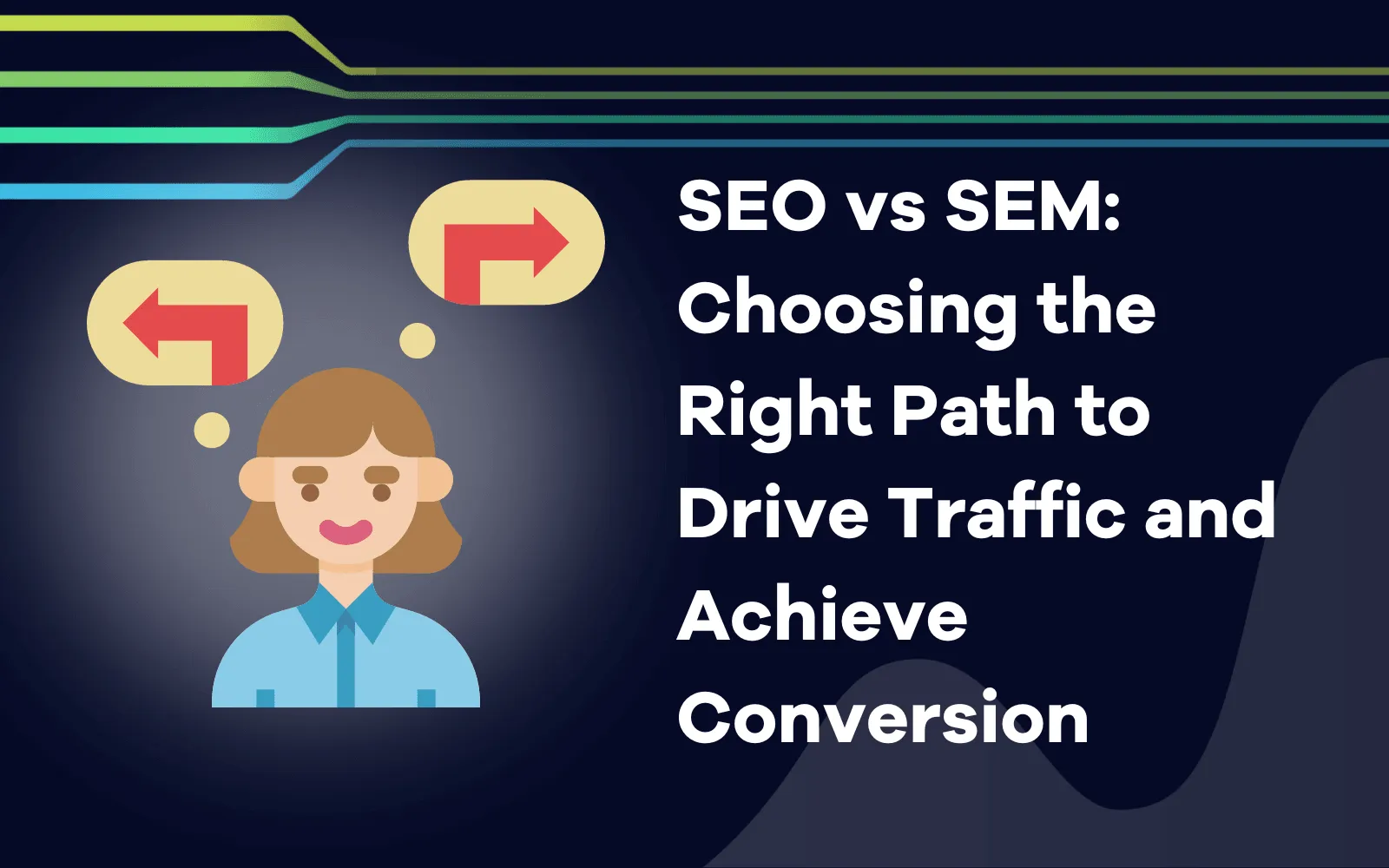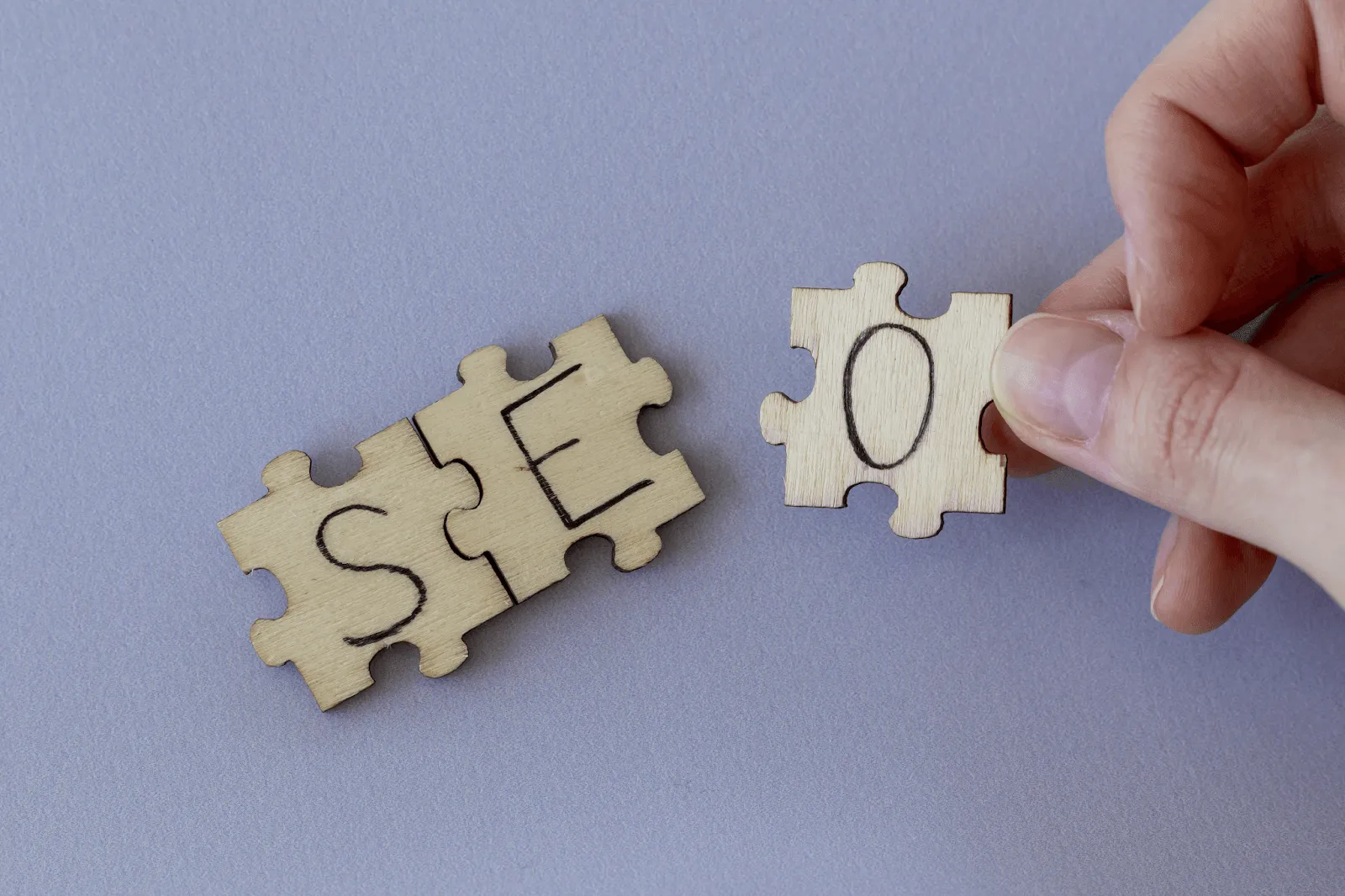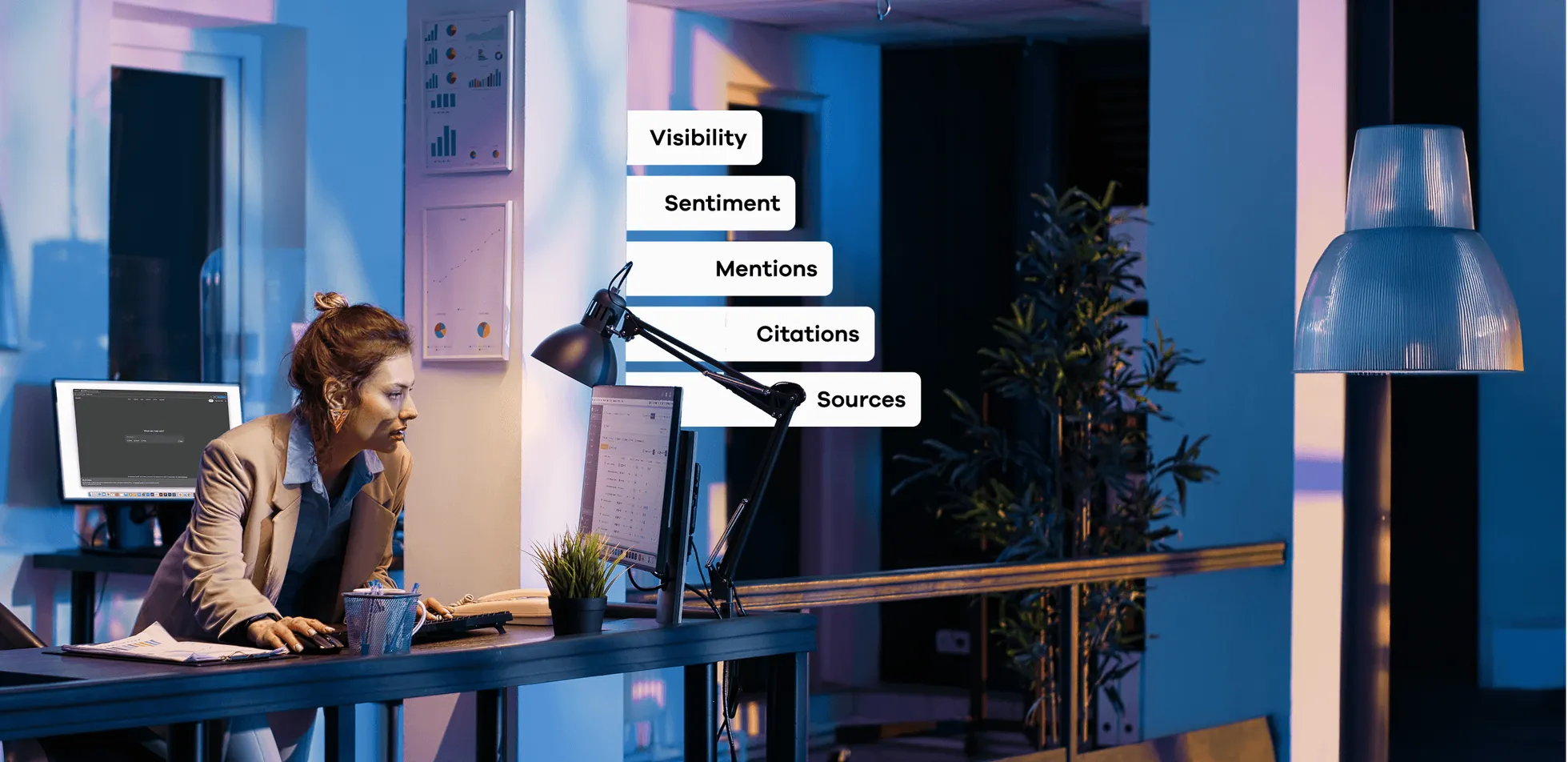
SEO vs SEM: Choosing the Right Path to Drive Traffic and Achieve Conversion

Nikola Baldikov
November 28, 2023
Discover the key differences between SEO and SEM and learn how to choose the right path to drive traffic and achieve conversions for your website. Uncover insights, strategies, and tips to optimize your online presence effectively.

Ever since Google’s launch in 1998, businesses have tried to strategically position themselves there for good reason. Whether targeting B2B or B2C customers, Google as the world’s most used search engine (90.1% market share), can offer amazing benefits. In short, its power can be leveraged through paid efforts or organically. And this is where search engine marketing (SEM) and search engine optimization (SEO) shine.
These two frequently confused terms should be viewed as a puzzle. The small puzzle pieces are SEO, paid advertising (PPC), social networking, content marketing, web design, and others. SEM is the final picture that emerges. It is, therefore, an all-encompassing term for both paid and organic efforts aimed at generating traffic to a website.
In this article, we explore both SEM and SEO and look at their differences and similarities. We also suggest a way forward for businesses seeking to implement such strategies. So, without further ado, let’s take a closer look.
Search Engine Marketing (SEM)

Source: Freepik
Because SEM is concerned with both paid for and organic traffic (SEO) on search engines such as Google, we’ll cover SEO separately in the next section and focus on the paid SEM aspect now.
As frequent Google users, we have come to identify different search results whenever we type in a search query. The very first result on some pages are adverts. Naturally, these are paid for by organizations seeking the top spot, greater visibility, more leads, click-through rates (CTRs), and of course - paying customers. In short, this is called pay-per-click (PPC) or cost-per-click (CPC) advertising as part of the core SEM techniques.
However, the process of placing an ad on Google requires a strategy. It all starts with understanding your target audience and what you are aiming to offer them. Once you’ve figured this out, it’s about assigning key performance indicators (KPIs) to your goals. You’ll then need to do thorough keyword research to better understand how to target your ads for optimal results. Next, it’s time to create your ads using these selected keywords.
Of course, the ad creation process should also contain appealing visuals. Furthermore, once your audience clicks on your ad, they need to be taken to a specially dedicated landing page where you encourage them to take a certain action, such as buy. And finally, it’s about measuring the performance of each ad campaign to ensure that it was successful and that it met your KPIs. You can also test and further refine your ad campaigns through A/B testing.
When all is said and done, placing paid ads on search engines comes with multiple benefits. Among these include:
A practically instantaneous approach that reaches your audience immediately
A strong way to boost a business’ brand awareness among its audience
They offer a greater levels of control and can be highly targeted, leading to higher traffic
Ads can be optimized which means you can further refine them for greater impact
Ads can be placed, grouped, and maintained much faster and more easily
Ads are a quick way of measuring performance over the short-term (e.g. clicks, impressions, CTRs, cost-per-acquisition (CPA), etc.)
There are numerous Google Ad campaigns such as search, display, Gmail, shopping, and YouTube ads
On the flip side, placing ads requires that a business incurs a cost paid to Google or other search engines every time a user clicks on your ad. That’s because you are competing with other businesses for the specific keywords you’re targeting.
Search Engine Optimization (SEO)

Source: Freepik
Also called “organic SEM”, SEO is where your unpaid website traffic comes from. For most individuals/companies, this comes in the form of having a blog on their website.
What do we mean when we say unpaid traffic? It’s when a user types in a search query into a search engine and results other than paid ads appear. These “blue link” results are generally ranked from first place to last in order of relevance. But how does Google know what’s relevant? In short, its bots crawl websites and index them. Then, the most relevant information is extracted and ranked into search results.
And this is where the battle starts. Many businesses and organizations may be competing for the same search terms or user queries. So, how does one stand out apart from the competition? The answer comes in the form of important SEO tactics and techniques that include:
The quality of your backlinks and referring domains with a relevant anchor text
Effective internal linking
Whether you have effective meta titles and descriptions
A well-structured and optimized URL
Implementing schema markup
Strong keyword research
Good use of different types of headings and subheadings
Quality and quantity content that makes effective use of stop words and adds value to users and to Google
A quick loading website that’s adapted for mobile searches
Optimized images through alt text
Simple and easy navigation for users
User-friendly design and content layout through the use of headers and bullet points/lists
Each of these techniques can be further subdivided into three core areas of SEO, which are on-page (optimizing for keywords), off-page (a diverse backlinks portfolio), and technical SEO (optimizing for crawling and indexing).
What must be kept in mind with SEO is that such efforts always yield results over the long term and it should not be looked at as a quick-fix. Instead, it requires strategic planning, content creation, optimization, and a strong understanding of your target market.
However, the benefits of SEO for an optimized website are enormous. Some of them include:
Organic SEO requires no payment to Google or other search engines
It is more easily recognized by search engine crawlers
Improved website rankings in the search engine result pages (SERPs)
Offers an improved user experience
Stronger brand visibility and credibility
The ability to focus on more organic terms as opposed to paid ones
You’re more likely to earn more clicks than through paid ads
Stronger organic traffic (measured by sessions, users, and new users)
Better engagement signals (such as time on site, CTR, pages per session, etc.)
Lowers a website’s bounce rates
SEO vs SEM: Differences
Going back to the puzzle piece analogy, which necessarily implies that every piece is different, in the world of online marketing, there are also major differences between SEM and SEO. Fundamentally, the differences relate to:
Purpose: SEM strives to promote visibility in the SERP though paid ads while SEO attempts to boost visibility in the SERP through organic strategies that take some time to generate traction and results.
Cost and ROI: SEM is a paid-for while SEO is a free strategy; both can yield returns on investment (ROI) but the frame of time differs.
Visibility: SEO can achieve higher visibility for you using organic methods.
Audience targeting: SEM enables hyper-personalization of ads whereas SEO doesn’t.
Time factor: SEM efforts can produce instant results whereas with SEO, you are looking at anywhere from six months up to a year or more.
Positioning on the SERP: paid-for ads or SEM strategies always appear before organic results that follow from the ads on the SERP due to SEO efforts.
KPIs: both SEM and SEO use different KPIs to measure success rates. Although they will both look at the number of clicks, other metrics may include time spent on the page and bounce rates.
Traffic potential and CTRs: SEM usually receives fewer CTRs as opposed to SEO, which drives more clicks and higher traffic. Traffic volume is generally higher through SEO than SEM but it is harder to predict.
Testing: A/B testing is quite popular and easy to do for SEM strategies, whereas SEO doesn’t have that option.
Competition: SEM gets higher competition due to bids placed on target keywords by competitors. This does not apply to SEO.
Complexity: SEM is less complex than SEO because SEO involves on-page, off-page, and technical SEO strategies.
SEO vs SEM: Similarities
So, what is the final result when you put SEM and SEO efforts together? They both:
Improve website visibility
Help ads and content appear in the search results
Drive a greater quality and quantity of traffic to your website
Require a deep understanding of your target audience
Rely on keyword research to get found by a user
Both can share data to inform strategy
Make use of different types of content to meet user needs
Require constant analysis, testing, refinement, and optimization
Choosing Between SEO and SEM
If you absolutely have to choose between SEM and SEO, you’ll need to consider a couple of important factors when making your decision. Some of these include:
What is the current performance of your website?
What are your business’ short- and long-term goals?
What is your marketing budget?
How much time do you need to achieve your goals?
How quickly do you want to see results? Conversely, how long are you willing to wait?
How much risk are you willing to take? With SEM, the risk is the cost involved, while for SEO, the risk is changes in the algorithm.
With these questions in mind, perhaps the most obvious answer is that SEM (PPC) and SEO should be used strategically and together to form a robust strategy that gives you access to Google’s real estate space while driving traffic to your website from two sources. The joint effects of a combined strategy have proven to work both in B2B and B2C scenarios and as such, they should be adopted as an integrated approach as opposed to being used on their own.
Wrapping up
SEM and SEO as a part of SEM are two highly important approaches to digital marketing. The differences between the two are quite clear in terms of approaches, time-frames, and costs. However, they both ultimately have the same goal: to drive website traffic and increase clicks.
Although you can always choose one strategy over the other, depending on your business goals, your ultimate aim is to use both SEM and SEO in a complementary manner to achieve better, more effective, and more enduring results.
Frequently Asked Questions (FAQs)
What is the difference between SEO and SEM?
SEO deals with organic search traffic while SEM deals primarily with paid-for search traffic and clicks.
Which strategy, SEO or SEM, is more effective for driving website traffic?
Both strategies can drive traffic to your website. However, SEM strategies often have instantaneous results while with SEO, your efforts can take months to show ROI.
Are SEO and SEM complementary strategies, or should I focus on one over the other?
SEO and SEM should be viewed as two sides of the same coin. In other words, both methods should be used to ensure long-term success and effective results for your website and business.
How long does it take to see results with SEO compared to SEM?
It can take several months to upwards of a year to see results with SEO. Meanwhile, you can see almost instant results with SEM.
What are the costs associated with implementing SEO and SEM strategies?
SEM strategies involve a cost to the business, depending on the size of your marketing budget. However, SEO does not require a payment to a search engine and as such, these efforts are considered free.
Related blog posts

5 LLM Visibility Metrics You Should Track in 2026
SEO is now both about ranking in search engines and being visible in LLMs. We give you five visibility metrics every SEO should track in 2026.
3 December 2025Is LLM Tracking Relevant for You?
LLM tracking is not just for SEOs. It is also relevant for content teams, agencies, marketing leadership, and communication teams. Learn why here.
26 November 2025
How to Find the Best Prompts to Track for AI Visibility
Do you want to start tracking prompts to optimize your AI visibility? We give you seven practical ways to identify relevant prompts to track in LLMs.
9 November 2025
